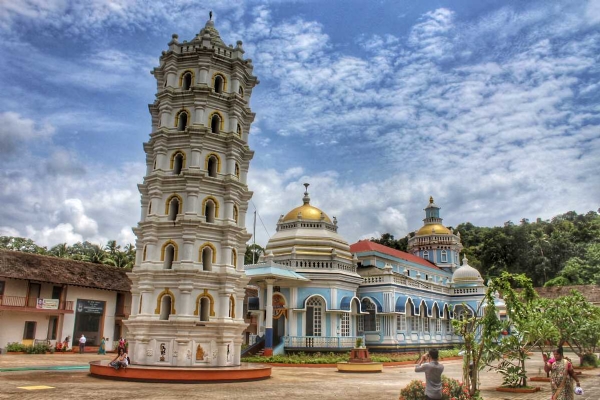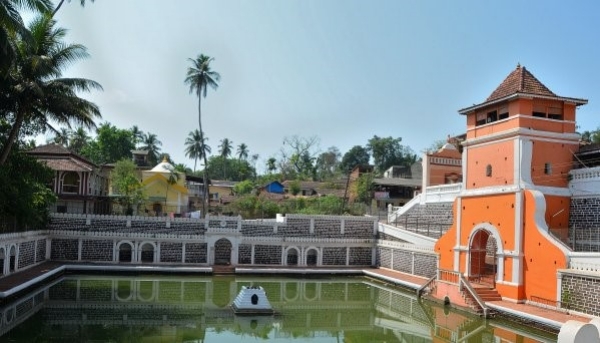Shri Mangeshi temple: The 4 centuries-old beauty of Goa representing typical Goan Hindu style of architecture
Most of the temples in Goa are known for their defined architecture and distinctive style
Total Views |
Contrary to popular belief, Goa is a lot more than beaches. The beauty of the architecture and history present in this state will leave you stunned. We will explore one such stunning structure today, that both extremely sacred and etched with elegance. The Shri Mangeshi Temple is a splendid temple in Ponda taluka, Goa, dedicated to Lord Shiva. It is the most important temple in Goa, being 450 years old, and representing the typical Goan Hindu style of architecture, with its magnificent domes and water tank. It is situated on a hill in Priol, surrounded with lush greenery. 22 kms from Panaji, and 26 kms from Margao. The temple is one of Goa’s the largest, wealthiest and most frequently visited.

The Mangesh Linga is considered to have been holy on the Mangireesh mountain on banks of Bhagirathi by Lord Brahma himself, from where the Saraswat Brahmins brought it to Trihotrapuri, Bihar. They carried the linga on to Gomantaka and settled at Mathagrama, the present day Madgaon, establishing their most sacred and ancient temple of Mangesh on the banks of the Zuari as it is called today.
In the temple is a prominent Nandi Bull, the Shiva’s vahana. The temple complex consists of a spacious courtyard surrounded by the temple itself, and rooms for weddings and pilgrims. The temple also has a magnificent water tank, which is believed to be the oldest part of the temple.

Most of the Goan temples are known for their chiselled architecture and distinctive style. A beautiful 7-storey deepstambha, typical of Goan temple architecture, stands at the gates in the temple complex. It is set against a sylvan backdrop of woodlands and rolling green hills.
Shiva had taught her an incantation, “He Girisha mamtrahi” (O Lord of the Mountains, protect me) but she was so frightened that she lost her coherence, uttering a jumbled incantation, “Trahi mam Girisha”. Shiva, who had taken the form of a tiger, instantly came back to his normal form. Then, at Parvati’s request, he added Mam-Girisha to the many names He is known by. This is also how the village (where the temple is), came to be eventually known as Mangeshi - abbreviation of Mam-Girisha.

History | The temple’s origins are from Kushasthali, (now Cortalim), a village in Salcette. At the time, Salcete was under Portuguese rule in 1543. This temple was preserved until the onset of the inquisition from Europe in 1567. In 1560, the Portuguese started Christian conversions in Salcette. This made the Saraswats of Vatsa Gotra insecure.
They shifted the Mangesh Linga from the original site to present place on May 1st, 1560 A.D. to the locality now known as Mangeshim in Priol village, of Atrunja, which at that time was ruled by the Hindu kings of Sonde.
Shri Mangeshi Mahadev in Goa. One of the most beautiful mandirs I have ever visited. It's situated in North Goa area. The earlier temple was demolished by Portuguese after which the devotees moved it to current location. Mangeshi Mahadev is Kul devta of Saraswat Brahmins. pic.twitter.com/RmDR6QRVX9
— Rahul Kaushik (@kaushkrahul) July 10, 2019
After remaining in the home of a temple priest for a while, Shri Mangesh deity was finally installed in its present site at Priol. The current temple structure was only built under Maratha rule. 150 years after it had been moved, Peshwas donated Mangeshi village to the temple in 1739 on suggestion of their Sardar, Shri Ramchandra Malhar Sukhtankar - a staunch follower of Shri Mangesh. Only a few years after being built, this area too, fell into Portuguese’ hands in 1764. By now, the Portuguese had lost their initial religious zeal, and had became tolerant of other religions. Hence, the structure remained untouched.
The Mangesh Linga is considered to have been holy on the Mangireesh mountain on banks of Bhagirathi by Lord Brahma himself, from where the Saraswat Brahmins brought it to Trihotrapuri, Bihar. They carried the linga on to Gomantaka and settled at Mathagrama, the present day Madgaon, establishing their most sacred and ancient temple of Mangesh on the banks of the Zuari as it is called today.
In the temple is a prominent Nandi Bull, the Shiva’s vahana. The temple complex consists of a spacious courtyard surrounded by the temple itself, and rooms for weddings and pilgrims. The temple also has a magnificent water tank, which is believed to be the oldest part of the temple.

The Sabha Griha is a hall which can accommodate over 500. The decor has chandeliers of 19th century. The central part of the Sabha Griha leads to the Garbha Griha, kept clear at all times. This allows the devotee to have the darshan of the Lord even from the entrance. The garbh griha has shrines of Parvati & Ganesha.
Most of the Goan temples are known for their chiselled architecture and distinctive style. A beautiful 7-storey deepstambha, typical of Goan temple architecture, stands at the gates in the temple complex. It is set against a sylvan backdrop of woodlands and rolling green hills.
Also Read | Chennakeshava temple: the 12th century wonder of Belur
According to legend, once, Shiv and Parvati were playing dice at Mount Kailas. Shiva kept losing, and in the last roll of the dice staked his heaven. Having lost that too, he had to leave Himalayas. He wandered southwards and crossed the Sahyadri mountains. He came to Kushasthali, (now Cortalim), where Lopesh, his faithful devotee, entreated him to remain. Parvati became heartbroken without Shiva, left heaven and went in search of him. In the midst of a dense forest, she came face to face with a huge tiger.
Shiva had taught her an incantation, “He Girisha mamtrahi” (O Lord of the Mountains, protect me) but she was so frightened that she lost her coherence, uttering a jumbled incantation, “Trahi mam Girisha”. Shiva, who had taken the form of a tiger, instantly came back to his normal form. Then, at Parvati’s request, he added Mam-Girisha to the many names He is known by. This is also how the village (where the temple is), came to be eventually known as Mangeshi - abbreviation of Mam-Girisha.


